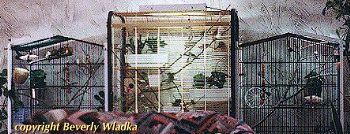
Aviaries can come in all sizes. One of the easiest forms an aviary takes is a cockatiel hotel cage. These cages, usually with dimensions of about 17W x 17L x 36h, make nice beginning aviaries. I would not recommend a cage smaller than this because aviary birds stay in their enclosure all their lives. We must remember, that although finches are small, they still require room to fly.
There are no set rules for the number of birds to place in an aviary. In the cage mentioned above, personally I would not want more than six birds. Basically, if it looks crowded, it probably is crowded.

The number of perches and feeding dishes for your aviary varies by the number of birds. For perches, an aviary provides a wonderful opportunity for design. Plants become natural perches that simulate a bird’s environment. Store bought perches may also be used. For each bird, you will need at least 3 inches of perch, and for larger, or more aggressive species the number can be increased. Ideally, each bird should have its own perch.
Several birds, provided that they eat the same general food mix, can eat out of the same dish. Large terra cotta plant saucers work great for this. If you have a large number of birds, two or three smaller food dishes may be better than one, ensuring that all birds get fed. The same rule applies to water dishes. Since many aviary birds, such as finches and canaries like to use their water dishes for bathing, you will want to provide one or two more water dishes than you need.
All these birds will make quite a mess. If you’re using a cage for an aviary, then simple newspaper liners may work. In a larger structure, spreading out newspaper may not be practical. Most of the large aviaries I have seen do not line the floors. Instead, the floor is usually a hard surface, and cleaned with a broom as needed. Some people introduce button quail into their aviaries, and these, cute, little birds peck the fallen seeds off the ground, making clean up easier.
You may also be wondering about noise. With any type of bird, the more you have, the noisier it will be. Finches do not screech like parrots; however, their calls can be quite voluminous, particularly if your entire aviary is calling back and forth. If you enjoy melodious bird song, then aviaries should not bother you. But, if you find the constant chatter of bird speech annoying, you may wish to limit your numbers of birds. Each species differs, making it hard to cite any hard and fast rule about noise level.
The aviary is set up, food and water dishes in place, now you can think about which birds you would like. Introducing new finches isn’t as difficult as you may think. If you’re stocking the aviary all at once, then everyone is introduced as newcomers. Placing a new bird into an established aviary usually isn’t a problem either. After a quarantine period, the new bird can be let free in the aviary. You will need to keep an eye on it for a couple of days to ensure that it is getting food and water, but no major fighting should occur.
There are two things to think about when deciding which species to put in an aviary. First, will they get along together. Second, do you wish to have the species interbreed.
Thankfully, most finches are docile creatures. Any aggression that may occur happens around breeding time. The easiest way to avoid aggression is to place birds of similar size together. For example, your smaller finches are usually 3 to 5 inches in length. This range includes the more common species such as societies and zebras. This will help to minimize aggression by ensuring that everyone is pretty much the same size. Some of your larger finches, such as Java rice birds, may do better with canaries, than with other, smaller finches.
Our second concern is hybridization. It is true that societies and other common species will interbreed. After all, we have spicity finches, which are a combination of spice and society. The only true way to avoid this is to do some serious research into which species will and will not interbreed. For societies, this may mean shying away from mannikins, and other mannikin type finches. Then again, a pair of societies may live happily with other like birds and the male, or female will never stray. Usually, this depends on the group of birds and may be a trial and error process. For the hobbyist who has done his or her research, this usually isn’t a concern, and any eggs created by an inter-species clutch can always be removed.
The biggest thing to keep in mind with any hobby is enjoyment. Granted, all of us worry now and again, but if you’re stressing out over your birds, then they don’t provide the relaxation and enjoyment they should.
Aviaries are a great addition to any all season porch or atrium. Getting to watch these birds with little or no human interference brings out their natural personalities. So, have a spare corner you’re not sure how to decorate? Think about an aviary, and you won’t be disappointed.

